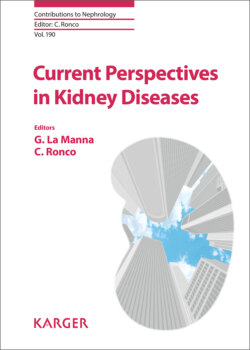Читать книгу Current Perspectives in Kidney Diseases - Группа авторов - Страница 11
На сайте Литреса книга снята с продажи.
Introduction
ОглавлениеSepsis and acute kidney injury (AKI) are 2 acute clinical syndromes that are tightly connected. From one side, AKI represents one of the most common complications of sepsis and on the other, sepsis risk is significantly increased by AKI development [1]. The concomitance of these 2 clinical syndromes, or sepsis-associated AKI (S-AKI), is related to an extremely poor prognosis with 28-day mortality rate ≥50% and a high risk of progression toward chronic kidney disease (CKD) in survivors, with increased healthcare costs [2, 3]. Nowadays, sepsis therapy is based on antibiotic administration and on a complex network of supportive cares that do not target the mechanisms of tissue injury: for this reason, several clinical trials aimed at selectively blocking “the magic bullet” involved in sepsis-associated tissue injury failed [4]. Furthermore, classical renal replacement therapies (RRTs) are not associated with an improvement of renal recovery rate, and have a questioned impact on patient survival in randomized clinical trials with a large number of patients.
However, in last years the scientific and clinical approaches to S-AKI have been deeply revolutionized. The 2001 sepsis definition was focused on the interplay between pathogens and immune cells and the consequent Systemic Inflammatory Response Syndrome (SIRS). Subsequently, large observational studies clearly demonstrated that several septic episodes are not simply related to SIRS and that SIRS detection has a poor clinical utility [5]. Indeed, different tissues implement aberrant responses to infections independently from the immune system. Based on these considerations, in 2016 sepsis was re-defined as “a life-threatening organ dysfunction caused by a dysregulated host response to infection” [5]. Moreover, in the recent years new insights have changed the scientific and clinical approaches to S-AKI, leading to some encouraging results. In particular, “Omic” technologies (i.e. genomics, transcriptomics, proteomics and metabolomics) allowed the development of new biomarkers of outcome and tissue injury. In addition, biotechnology advances in the field of extracorporeal techniques lead to the improvement of treatments aimed to remove the circulating inflammatory mediators involved in the pathogenesis of S-AKI.
The aim of this paper is to review the current extracorporeal therapies available for the treatment of S-AKI, with a particular focus on the most promising techniques known to interfere with the molecular mechanisms involved in renal microvascular derangement and tubular epithelial cell (TEC) injury, key features of S-AKI at cell biology and molecular level.
